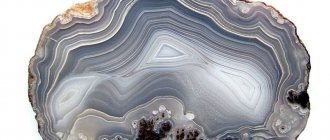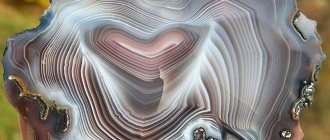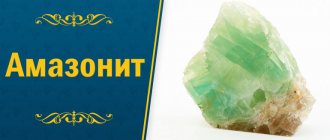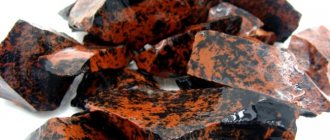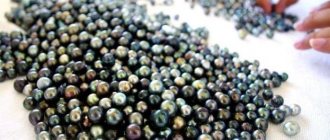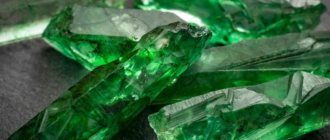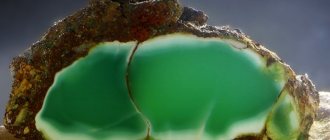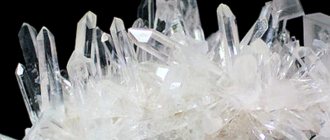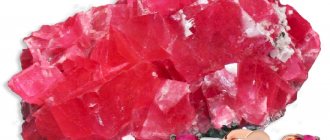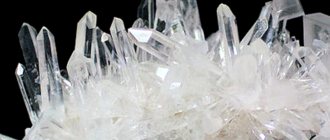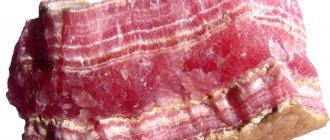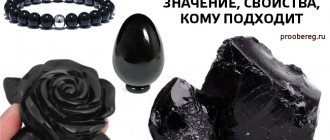The beauty of the world of jewelry has attracted more than one generation of lovers of natural jewelry. Throughout this period, people are faced with the same question: how to distinguish a fake from a real gemstone? Even in ancient times, craftsmen successfully replaced precious stones with various imitations, finding them not only among natural, cheaper analogues, but sometimes even replacing them with simple glass.
Aquamarine is a popular natural stone that is often tried to be imitated. This time we’ll figure out how to distinguish an aquamarine from a fake.
Aquamarine stone - history
Despite the fact that aquamarine has been known to mankind for several millennia, in ancient times jewelry was not made from the stone (there is not a single one). The Romans, although they were familiar with many methods of melting and processing metals, did not know the technique of cutting precious stones.
In the Middle Ages, bright gems were very popular: garnet, ruby, sapphire. The stones were cut in the form of a cabochon - a polished flat stone in the shape of a drop or round. The fashion for aquamarines began in the 18th century, when, in the era of romanticism, preference was given to light pastel fabrics and white decorations.
Compatibility with other stones
Topaz London Blue captivates with its deep color. In jewelry it looks expensive and presentable without any additions. In some cases, the blue hue of the gem is emphasized by the shine of diamonds or amethysts, combining precious stones with each other.
Precious white metals - high-quality silver, white gold and platinum - emphasize beauty and enhance energy.
Aquamarine - what it looks like in nature
Aquamarine is a type of beryl, so the stone has a bright shine and uniform color. Classic aquamarines have a bright blue color, the second name of the gem is Noble Beryl.” The closest relatives of the mineral are emerald and sapphire.
Aquamarines are mined in underground mines and have the shape of a hexagonal prism; the transparent stone may contain tubular needle-shaped inclusions, a bubbly structure, and particles of pyrite and rutile.
Precious or not?
Many people think of aquamarine as a gemstone, but it is not. The mineral does not belong to the class of rare and does not have the characteristics of precious stones (hardness, optical properties, purity, etc.). Jewelers classify aquamarine as a second-class or semi-precious stone. The same category includes zircon, topaz, chrysoberyl, noble spinel, etc., but aquamarine is superior in price to many minerals.
The most valuable are sky blue pure aquamarines weighing 10 carats or more. Minerals are used to produce expensive jewelry. One of the largest aquamarines adorns the crown of the Queen of Great Britain, the weight of the stone is 184 grams or 920 carats.
About imitation natural stones
Considering that the art of creating counterfeit jewelry has successfully developed over many centuries, it is not surprising that it has advanced significantly. Modern jewelry techniques make it possible to “ennoble” lower-grade natural minerals in various ways so that they do not differ from more expensive ones, using annealing, crack filling, irradiation, and surface coating.
The production of synthetic analogues is now carried out on an industrial scale. Moreover, thanks to the achievements of modern technologies, they are not only indistinguishable in appearance and have full compliance with physical characteristics, but sometimes even surpass natural ones in quality. However, it should be noted that natural minerals are always valued much more expensive than artificial ones.
Buyers often have to deal with multiple attempts to pass off artificial stones or ordinary colored glass as a gemstone. Therefore, you should have at least the necessary minimum knowledge so as not to become a victim of deception.
Aquamarine - color and shades
The most common and expensive color of the stone will be blue; in addition to sky blue, aquamarines can be blue, with a green tint, or light blue. Aquamarines are not called sea stone for nothing; they can come in all shades of the sea. Rare amber aquamarine resembles the foam of a dirty ocean; the stone is quite cloudy.
Gray aquamarine resembles the sea during a storm, it is a very rare shade of stone, but even rarer is black aquamarine stone. The molecular structure of the mineral creates a unique light effect of the stone - dichroism, its faces refract light rays differently, so the black and gray color of aquamarine can only be seen from a certain angle and a certain type of lighting.
In addition, the color saturation of the stone depends on the time of day. In the sun, aquamarine will be almost colorless, but with the onset of evening it will acquire a bright blue or blue color.
Difference from similar colored gemstones
When wondering how to distinguish natural aquamarine from those similar in color, you should decide on analogues of minerals that exist in nature, which closely resemble it.
Among similar stones, which at first glance do not differ from ours, we can highlight the following:
- blue topaz;
- sapphire;
- zirconium;
- spinel.
You can distinguish topaz from aquamarine by the more characteristic shine and play of light in the facets of the first. Blue topaz is often cheaper than aquamarine, so unscrupulous sellers pass it off as a sea green mineral.
If we compare it with zirconium, the latter stands out for its pronounced birefringence. Raising it to the light, you can see a peculiar bifurcation of the edges.
It differs from blue sapphire in its refractive index, which can be measured with a special refractometer. In sapphire it is much higher.
Physical and chemical characteristics
Aquamarines are one of the most beautiful varieties of beryl. Like all beryls, the stone is quite hard, but at the same time fragile; jewelry with a marine gift requires careful handling.
Depending on the iron content in the crystal, the greenish tint of the mineral is determined; the more iron, the richer the color. Physical properties of aquamarine:
- Crystal nucleation occurs in igneous rocks at a depth of 2 kilometers.
- In the sun, the stone loses color.
- When exposed to high temperatures, aquamarine darkens and loses transparency.
There are two types of minerals found in nature: uniformly colored and zonal. The most famous aquamarine with zonal coloring was the Marambaya crystal, weighing 110 kg, mined in 1910. The center of the crystal was bright blue, the edges glowed with a green tint, and yellow stripes were visible in between. The most famous aquamarines:
- “Kachasina” - 62 kg.
- “Marta Roja” - 34 kg.
- “Etrela Dalva” - 22 kg.
In 2022, an aquamarine deposit was discovered in Ukraine; the weight of the crystals reaches 15 kg. The stones are distinguished by their extraordinary purity due to the fact that the layer of crystals is located in the windy field of the Carpathians.
Physicochemical characteristics
London Blue Topaz is a refined colorless topaz of natural origin, which in chemical composition is aluminum orthosilicate.
The mineral formula is Al2[SiO4](F,OH)2. Impurities present in the composition are iron, titanium, silicon, vanadium.
Main physical characteristics:
| Index | Description |
| Mohs hardness | 8 units |
| Color | Muted, smoky blue |
| Shine | Glass muted |
| Fragility | Increased |
| Transparency | Absolutely transparent, translucent |
| Density | No more than 3.57 g/cm³ |
| Kink | Uneven, conchoidal |
| Cleavage | Perfect |
| Exposure to external influences | Sensitive to ultraviolet radiation, moisture and sudden temperature changes |
Aquamarine stone - healing properties
The healing properties of aquamarine were discovered by the ancient Persians and Romans. Warriors took the crystal with them to treat their throats and disinfect water during the campaign. In addition, the stone was used to treat diseases of the liver and stomach.
Modern lithotherapists also confirm the healing properties of the mineral for the following diseases:
- elevated body temperature with acute respiratory infections;
- seasonal allergies;
- thyroid dysfunction;
- diseases of the gastrointestinal tract, liver.
Earrings with aquamarine effectively eliminate toothache; massage using the mineral eliminates periodic pain in women and relieves anxiety. It has been noticed that simply admiring or talking with a stone quickly lifts a person out of a state of depression and increases the body's resistance to stress.
Topaz or aquamarine?
You can often hear the opinion among ordinary people that blue topaz cannot be distinguished from aquamarine. And therefore, in their opinion, they are trying to sell one stone instead of another to the buyer.
In fact, it is not easy to confuse these two stones. Topaz has a much brighter play of color, while aquamarine looks much paler. But experts determine topaz not only by its appearance; there is a refractometer device for this. With its help you can accurately determine whether the stone in front of you is topaz or aquamarine.
To distinguish between these two stones at home, there are no less accurate criteria. For example, the density of topaz is much higher, so for the same volumes it is a third heavier. The difference in weight can be easily noticed. Gemologists also use this criterion: in their laboratories they have a special solution of high concentration salts, in which most minerals sink, including aquamarine, but not topaz.
There is an opinion that supposedly sun-faded topaz returns its color after a period of “rest,” but in practice it is not recommended to verify such a legend.
Aquamarine - magical properties
It is not for nothing that Aquamarine is very popular among travelers and sailors. An ancient legend says that the crystal is able to show the right path because it is a gift from a mermaid.
In ancient times, the first sailors caught from the depths of the ocean a chest in which a blue stone of extraordinary beauty was kept. The travelers kept the find for themselves, but it turned out that it was the property of a mermaid, who sailed and began to demand the return of the sea talisman. The sailors got scared and began to beg the mermaid; in response to fervent requests, she left the stone for the sailors and the aquamarine became the talisman of the sea wolves.
Esotericists are deeply convinced of the magical properties of aquamarine, due to its influence on the astral body. The mineral enhances intuition (maybe that’s why travelers find their way home after talking with the stone).
- Forms protection against negativity.
- Helps resolve conflict, enhances the power of calm persuasion.
- Aquamarine bracelets bring joy to the wearer.
- Protects lovers.
Helps to recognize lies. But it is worth remembering that aquamarine will not tolerate lies and the owner - it will begin to become cloudy and crack.
Aquamarine, Paraiba, topaz or glass?! Admin: Glass
In the mid-80s, my parents purchased a set of three stones from a family friend who worked for a long time in the USSR diplomatic corps in Mexico and South America. These stones were purchased either in the south of Mexico or in Venezuela, it is no longer possible to find out for sure, along with several emeralds, in some very large cutting workshop, where local partners took him. Attached to the stones were documents in which this set appeared as “emeraldino”, which is how Mexican customs officers declared it when he exported them to the USSR. Of course, no examination was carried out. The weight of the stones is very decent, the stone in the ring is more than 1.5 cm in diameter. They were set in gold in the late 80s, there are no samples, they melted down some of their own jewelry. I really hope for your help - it makes sense to get an expert opinion on the stones, or just wear it every day, like jewelry.
Finally, about what alarmed me. If it was written Esmeraldino (?), then there is such a name for precious stones in one of the European languages. But if, like yours, Emeraldino, then this is the trade name of synthetics from an ancient year of manufacture. There is no such word in European languages. But anything is possible. Based solely on your information and also on the analysis of the color of the stones, we must conclude that you still need to go to a specialist. However, try not to make it too expensive. For example, there are citizens who do not take money if the conclusions are negative. These are the people you need to find. Good luck.
Mom will probably be upset, 700 rubles were paid in Soviet money for her favorite stones, what a terrible amount of money it was. And for me the intrigue is only growing. I don’t want to look for good other gemologists, I want to go to your merciless, sarcastic and angry ones! And I brought a couple more of my own, I have mounted imperial topazes. Bought in the 90s at the gemological fair at VDNKh. And an aging diamond of a strange cappuccino color!
Is it possible to make an appointment by phone and come?
Source
Aquamarine stone - who suits it according to their zodiac sign
Aquamarine amulets will help all zodiac signs get rid of addictions and envy. If the aquamarine has darkened, the owner experiences anger or negative emotions.
Aquamarine is suitable for all representatives of the element of water; for fish, crayfish and scorpios, an amulet made from the mineral will become a reliable protector and healer. Aquamarine will restore mental balance, relieve anxiety and fears, strengthen the immune system and bring joy.
Aquamarine also does not ignore other signs.
Aquarius will bring strengthening of marriage bonds.
Libra will be able to resolve important issues, the mineral will become a patron in business negotiations.
For Taurus, the crystal will help on the path to spirituality, since the earth sign is very attached to the material world.
Gemini will get rid of the contradictions inherent in their nature and gain confidence in oratory and political activity.
Virgos will get rid of self-criticism and dissatisfaction with others.
Representatives of the fire element - Leo, Sagittarius and Aries - are recommended to wear aquamarine from time to time. The element conflicts with water, but the stone will help smooth out the sharp edges of fiery characters.
Topaz
In nature, there are several types of topaz of different colors. But the most popular is sky blue topaz. This translucent cold stone simply fascinates with its crystal-clear shine.
But in addition to its excellent appearance, topaz is also valued for its properties. As a talisman, topaz brings success and material wealth to its owner, imparts honesty and objectivity. And besides, it will help to achieve favor and good attitude from others.
He is a strong protector of his owner. It protects him from the “evil eye” and other negative influences.
Topaz is extremely useful for stress, nervous breakdowns and mental disorders, helps with insomnia and relieves fears and phobias. It balances a person’s feelings and emotions, directing them in a calmer and more correct direction.
Decorations and price
Aquamarine is classified as a second-order or semi-precious gemstone. The crystal is processed with an emerald cut; crystals weighing over 10 carats are considered valuable.
The cost of a stone depends on the size, color and purity of the crystal; there are jewelry for 10 dollars, and there are several millions. An important factor remains the type of metal into which the aquamarine is set. Average prices of jewelry on the market:
- Ring with aquamarines in a silver frame - from RUB 5,000.
- Gold ring - from 15,000 rubles.
- Bracelets without frames - from 500 rubles. with medium size beads.
- Earrings in silver - from 4,000 rubles.
- Gold earrings - 20,000 rub.
Do not forget that jewelry is valued not only for the composition of stones and metals, but the work of the craftsman is also taken into account.
Verifying the authenticity of a stone using examination
The most reliable method for determining the naturalness of a gemstone is to conduct a professional examination. It implies a series of activities aimed at studying the minerals in the composition of the jewelry or loose in it. Key objectives of the examination:
- Determine the rock of the mineral;
- Establish or deny the authenticity of precious material;
- Classify jewelry in accordance with international or Russian standards for assessing jewelry.
Based on the results obtained, the specialist determines the exact cost specific to a particular mineral.
A jewelry (aka gemological) examination is carried out by a board of jewelers. Each of them carries out research independently, determining the nature of the mineral’s origin, its variety, weight and other important characteristics. After all experts have completed their work, the results of each are presented for comparison and further adoption of a collegial decision.
How to spot a fake
Today there are a large number of artificial rubies, garnets, and topazes on the market, but they have not yet learned how to grow aquamarine in laboratories, so natural aquamarine is always a natural stone. Aquamarine is often passed off as quartz, agate or topaz - the cost of these stones is much more expensive.
Aquamarine is often passed off as simple glass or blue corundum - the minerals cost pennies and it is not always possible to recognize a fake the first time, which is something you need to remember in order to buy real mermaid tears.
There are no bubble inclusions in aquamarine. If bubbles are visible in the crystal, it is most likely artificial spinel.
Topazes sparkle brighter, but do not give the silver reflection of aquamarine.
Plastic or glass will quickly heat up in your hands. The natural mineral will remain cool for a long time.
The most expensive ones on the market are blue aquamarines; there are quite a few of them. The cost of the stone is from $150 per carat. But blue aquamarine is not always a natural color. At high temperatures, blue aquamarine is darker and scammers simply calcinate the blue crystals to obtain a rich blue color.
Difference from cheap fakes
Considering the absence of synthetic analogues on the jewelry market, remember that if you come across a product that says “artificial aquamarine,” this can only indicate a fake. In such imitations, simple glass or spinel is most often used.
- Unlike natural stone, all glass imitations feel warmer to the touch . It is enough to touch such a stone, holding it with tweezers, with your tongue. If it remains cold, this is a natural aquamarine; if it becomes warm, it is a fake.
- Natural stone always has small flaws : foreign inclusions, air bubbles. It won't be perfectly smooth.
- Natural aquamarine is completely transparent and has a glossy rather than oily sheen .
- Its shade will not be flashy.
- As already mentioned, a real mineral changes shade at a certain angle of inclination . This property is called pleochroism.
How to wear aquamarine
Aquamarine jewelry, both gold and silver, is suitable for everyone, regardless of gender and age. Stylists give preference:
- Brown-eyed girls are more suited to aquamarines of rich blue and blue colors in a gold frame.
- For blue-eyed people, stones set in silver are recommended.
- For young girls, bracelets and earrings with small aquamarine in light blue color are suitable.
- Women over forty will look good on massive beads and bracelets made of large crystals.
If we talk about clothes with light stone, light fabric in pastel shades is ideal. But an aquamarine ring under a formal black suit also looks elegant.
Astrologers advise buying a new aquamarine on the 3rd lunar day if the stone is blue and on the 14th day if the aquamarine is green. You need to put on a new thing (trying on does not count) no earlier than after 14 days. Keep the stone away from the sun and give the decoration some attention every day. Astrologers believe that in two weeks the stone gets used to the owner and adapts to his energy.
Production and deposits
London Blue is a natural gem that, under the influence of radioactive radiation, acquired a rich blue color. Topazes with similar colors exist in nature, but this term applies exclusively to artificially colored specimens.
Colorless topaz (bottom right) grown on a polychrome tourmaline crystal. Afghanistan
The basis for obtaining London Blue topaz are colorless samples of natural origin. They are mined in Germany, Afghanistan, Ukraine, Pakistan, USA, Namibia, Great Britain and Sri Lanka. In Russia, deposits of colorless stones are located in the Ilmen Mountains.
How to care for aquamarine
Despite the fact that the mineral belongs to the class of hard stones, aquamarine is quite fragile, so care for the jewelry is appropriate.
- Clean the stone with a soft felt cloth and wash it in a solution of mild soap.
- Aquamarines cannot be cleaned with ultrasound - the crystal will crack.
- Sea stone is not worn in hot weather; aquamarines fade from sunlight and become transparent.
- Store jewelry in closed boxes away from heat and light.
We really hope that you liked the material about such a beautiful stone as aquamarine and found it useful. Write, comment, be sure to tell us where and how much you bought jewelry with aquamarine for and how true the advice of lithotherapists and astrologers is. Warmly, Our Authors team.
If you liked the article, share it on social networks, it’s important to us
Tags: aquamarine stone properties, who is suitable for it
Storage and care
London Blue, like other varieties of topaz, is not resistant to aggressive environments. In order for the mineral to maintain its integrity and original color, certain rules must be followed:
- Do not wear products with stones in sunny weather, do not leave them in direct sunlight.
- Avoid contact with water (both fresh and salty); the product must be removed before visiting the beach, pool, bath or sauna.
- Avoid exposure to sudden temperature changes.
- Protect the stone from the influence of any chemicals, be it household chemicals or cosmetics.
- Avoid mechanical impact - sharp impacts, falling from a height, squeezing, chipping.
- Store London topaz in a separate box or case with soft padding inside at room temperature with average humidity.
- Clean the stone periodically using a damp cloth. Immediately after wiping it should be dried. In case of severe contamination, it is better to take the crystal to a jeweler for cleaning.
London Blue Topaz is not intended for everyday wear. Jewelry with this mineral is classified as premium, so they are worn mainly in the evening and at night for social events and gala receptions.
Sapphire
Sapphire is a stone of a rich, deep dark blue color. It can rightfully be called one of the most noble and beautiful stones.
It is also considered a stone of fidelity and true, pure love. He protects relationships and family hearth.
In addition, the owner of a sapphire will receive a real muse in the person of this stone, since sapphire reveals a person’s creative potential and develops his abilities in this area. It helps awaken creative, extraordinary thinking and imagination, gives clarity to thoughts, and strengthens memory.
According to ancient Indian legend, sapphires were presented to people by the will of heaven by the supreme god Brahma, who poured the drink of immortality (which the gods drink at their feasts) - amrita - throughout the world. And these splashes that fell to the ground turned into sapphires. It is believed that people saw the reflection of Paradise in these shimmering crystals.
What is the difference between beryl and aquamarine?
Aquamarine - blue, greenish blue. Bazzit is pale blue. Noble beryl - apple green; noble ordinary - transparent, but with a pale color (the term is used mainly in jewelry).
Interesting materials:
Who voices the role of the Sultan in the Magnificent Century? Who voices the rose from the cartoon Barboskina? Who voices Rustem in the Magnificent Century? Who voices Shifu in Russian? Who voices the spool from Fixies? Who voices Shrek 2? Who voices The Rock Johnson in Russian? Who voices Sovunya from Smeshariki? Who voices Sultan Mahmud? Who voices the Sultan in the film The Magnificent Century?
Cut
In the photo: Aquamarine with a “large face”
Calibrated small light aquamarines are sold in a range of standardized sizes and shapes: circle, oval, rectangle.
Larger samples are cut individually. Due to the elongated shape of the crystals, the most advantageous and popular cut of aquamarine is the stepped (emerald) cut. With this form, the yield of pure crystals when cutting is greatest, compared to other forms.
Octagons, aschers and baguettes with correct, harmonious proportions in a step cut are very beautiful. Sometimes, instead of tiers-steps, wedge-shaped, princess (square) and radiant (rectangular) cuts are used, which look simply amazing!
But there is also a downside: often cutters, in pursuit of profit, use almost the entire length of the aquamarine crystal, so that the cut baguettes (rectangles) become like long thin sticks. It should be rightly noted that some jewelry houses like to play with this shape with an individual design, and very successfully, but in most cases, “sticks” due to the non-standard shape are of little demand, firstly, and secondly, there is a risk of damaging such a stone when setting and great cut
In addition to octagons and baguettes, cushion, pear, and oval shapes are popular. Pear-shaped aquamarines are used to create a romantic image of raindrops, for example, in earrings or a pendant. A pear-shaped aquamarine set in a ring will visually lengthen your fingers.
For aquamarine, as for other jewelry stones, the quality of processing is important. Three main cutting criteria can be distinguished: proportions, summary and polishing of the edges. Good cut quality means that all three parameters are presented at a high level. Aquamarines are highly polished, so there should be no noticeable tool marks on the surface of the faces. The problem for aquamarines is the disturbed proportions in the pavilion-crown relationship. Insufficient depth of the pavilion leads to the appearance of a “window” effect in the cut stone, when when viewed from the site, the surface on which the stone is located is visible. The excessive size of the pavilion part is inconvenient for fastening in the product, and, as a rule, is not economically profitable. You are overpaying for excess weight. There are exceptions, when a cut stone combines a low pavilion and a pronounced play of light on the edges; they are considered advantageous for the buyer, since they look larger than they actually are, and are more profitable in cost. For example, an 8 carat stone looks like 10 carats, but costs per carat like 8 carats. Such specimens are said to have a “large face.” Such aquamarines rarely appear on the market and are sold out quite quickly, since they are more of a lucky chance for the buyer than a constant value.
Why is it called precious?
The topaz gemstone has been known to humanity for quite some time. Certain characteristics of the gem, or rather its hardness, became the reason why crowns and symbols of power were encrusted with topazes.
Kings and monarchs loved crystals of various shades, assigning magical properties to them. Since the range of colors of topaz is amazing, it had many properties.
If you delve into the problem, you can immediately encounter problems, since in some countries topaz is classified as a precious stone, and in others - as a semi-precious stone.
In our country, such issues are resolved through legislation, but in some countries the laws are different. For this reason, topaz is regarded as a precious mineral, and the reason for this is not only the characteristics of the stone, but also its cost.
The rarest and most expensive are blue topazes; there are very few such stones left in nature. Most of the deposits that are familiar to humanity have almost completely exhausted themselves. The cost of such gems is very high.
But the technologies that people have owned since ancient times help combat the shortage. Minerals that are not brightly colored must be processed; they go through a refining procedure. The crystals are heated and exposed to radiation. As a result of processing, minerals become bright and acquire the desired shade.
It is difficult to recognize a substitution, since at its core, a crystal that has gone through the refining procedure is the same topaz that meets all the requirements. Only a bright color or shade can reveal the synthetic origin of a mineral, because those stones that are found in the bowels of the earth are distinguished by a soft color.
In our country, topaz is a semi-precious stone; it is not included in the list of precious stones for the reason that at the moment there are quite a lot of deposits in the world where topazes of various colors are mined.
Turquoise
Turquoise is counterfeited very widely, it is very difficult to find a stone that has not been counterfeited, and finding natural turquoise without defects is generally an almost impossible task. Turquoise is also counterfeited with plastic, but the result is not so porous and smooth.
Laboratory refining methods transform low-quality turquoise into more expensive ones. Enamel, compressed turquoise powder, and cheap minerals are disguised as turquoise. It is hardly possible to immediately distinguish crushed turquoise with glue from the real thing, but over time such a fake will acquire a dirty tint.
Diamond (diamond)
To imitate diamonds, a variety of materials and minerals are used: zircon, cubic zirconia, synthetic colorless sapphires, colorless artificial spinel and much more. It happens that it is possible to distinguish a fake from an original only with the help of special equipment. When visually inspecting a diamond, you need to know that natural diamonds are cut so that all light entering the stone is reflected from the back faces, as if they were a mirror row. So you cannot see light through a cut diamond, only a luminous point in the stone. It’s the same with a diamond set in a setting: you can’t see your finger through a stone in a ring, or your skin through a stone in a necklace.
Diamond is capable of cutting glass and leaves scratches on the polished surfaces of other gemstones. You can conduct several home experiments with a purchased diamond. In addition to glass, you can use other available materials. To make sure your diamond is not crystal glass, spinel, or synthetic sapphire, dip it in water or glycerin. Imitation diamonds in liquid will not be very visible, but a real diamond will shine. If you are sure of the authenticity of your purchase, you can test it with sandpaper. On a genuine diamond, sanding will not leave any damage, but other minerals will become rough.
